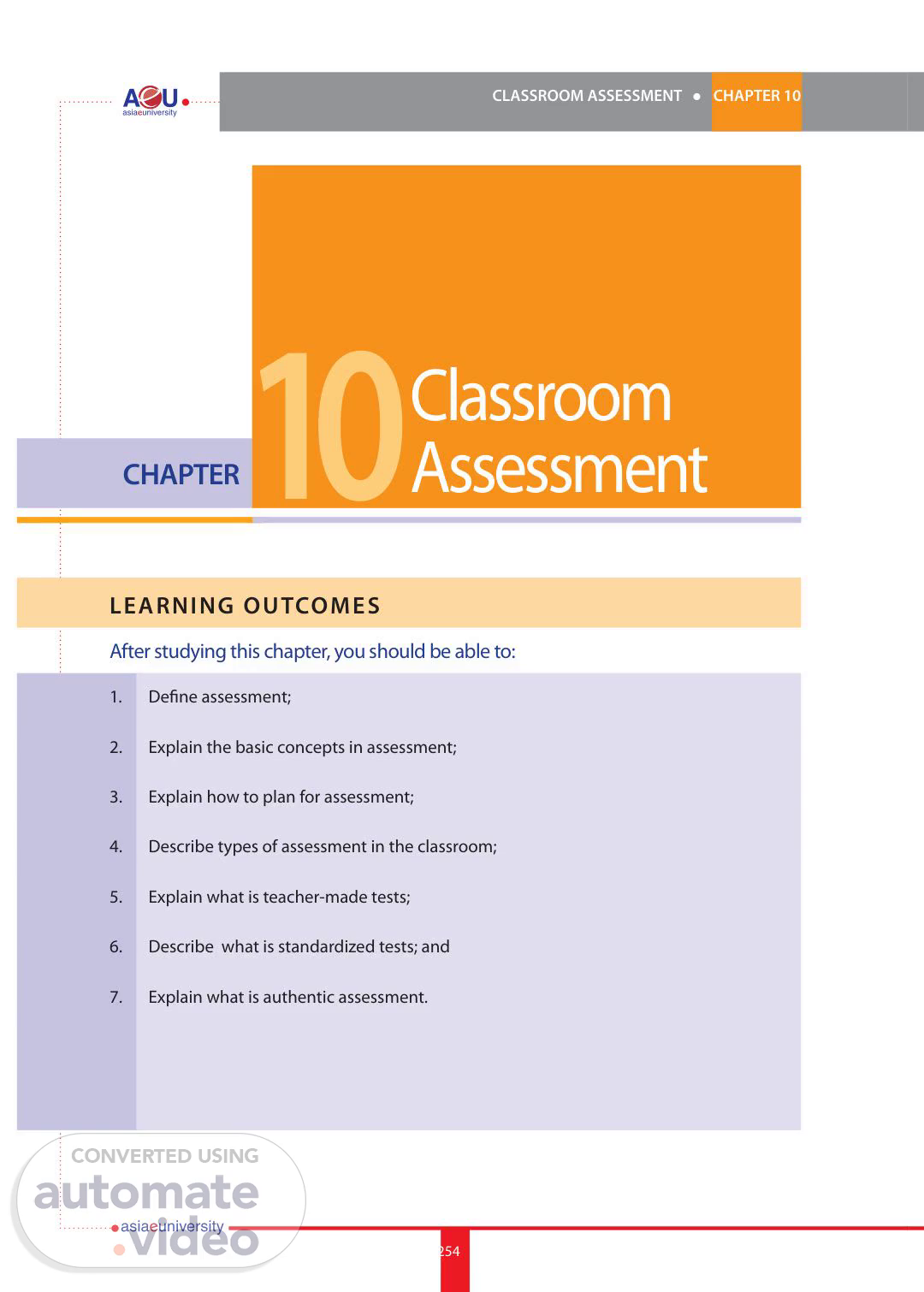
Main reading CHAPTER 10 - Introduction to Contemporary Classroom Assessment
Scene 1 (0s)
[Audio] CLASSROOM ASSESSMENT l CHAPTER 10 CHAPTER Classroom 10Assessment LEARNING OUTCOMES After studying this chapter, you should be able to: 1. Define assessment; 2. Explain the basic concepts in assessment; 3. Explain how to plan for assessment; 4. Describe types of assessment in the classroom; 5. Explain what is teacher-made tests; 6. Describe what is standardized tests; and 7. Explain what is authentic assessment. 254.
Scene 2 (40s)
[Audio] CHAPTER 10 l CLASSROOM ASSESSMENT INTRODUCTION One of the most basic and difficult task that teachers face in their work is the process of assessment. Classroom assessment includes all the process involved in making decisions about students learning progress. It includes the observation of students' written work, their answers to questions in class, and performance on teacher-made and standardized tests. According to (Koyalik, 2002 as cited in Eggen & Kauchak, 2004): 255 i. It facilitates teachers in decision making about learning progress through systematic information gathering. Besides that, assessment also accomplishes two other important goals; increasing learning and increasing motivation. The relationship between learning and assessment is very strong. Students learn more in classes where assessment is an integral part of instruction than in those where it isn't. Brief assessment that provides frequent feedback about learning progress is more effective than long, infrequent ones, like once-a-term tests. 255.
Scene 3 (1m 54s)
[Audio] CLASSROOM ASSESSMENT l CHAPTER 10 10.1 DEfINITION Of MEASUREMENT, EvALUATION, ASSESSMENT AND TEST Assessment, evaluation, measurement and test: all four terms have to do with the systematic process of collecting data and analysing those data to make decisions. These four terms may all mean the same thing, but there are some important differences among them, especially to teachers who engage in these processes in their classrooms. However, some experts give more narrow definitions of these terms. Below are the four narrow definitions of the terms: Measurement The process of gathering information about learning. it is the process of quantifying the degree to which someone or something possesses a given characteristic, quality or feature. The purpose of measurement is to produce quantitative data, such as test scores, numerical rating on assigned projects, height, weight, visual acuity and number of sit-ups completed in one minute. The numerical data generated in the measurement process are typically used in the evaluation of something, for example students' achievement. Evaluation The process of making decisions on the basis of measurements. For example, a school district may evaluate alternative approaches to teaching reading to determine which one work best with the students in serves. Teachers evaluate how well or to what extent their students are achieving instructional outcomes. Teachers also evaluate students at the end of the year to determine whether they are suitably prepared for the work expected at the next grade level. Good evaluation requires data gathering for informed decision making. Assessment The purposeful process in the classroom to collect data, both qualitative and quantitative. Hence, it is a broader term than measurement. For teachers, the purpose of assessment is usually to make decisions about students either as a group or individually. For example, teachers diagnose difficulties, verify learning after instruction, identify prerequisite learning and determine where to start in a learning sequence based on students already know. In the classroom, assessment considers students performances on tasks in a variety of settings and contexts. Assessment also may be intrusive or not, in other words, students may know that they are being assessed or it may be seamless with instruction, perhaps 256.
Scene 4 (4m 28s)
[Audio] CHAPTER 10 l CLASSROOM ASSESSMENT perceived bay the students as nothing more than a chance to practice what they have learned. Data collection in assessment is accomplished in a variety of ways such as observation of behavior, presentation of tasks for students to perform mentally and to record their response in writing or examination of products produced by the students. Test A question or a task or a series of such, designed to elicit some predetermined behavior from the person being tested. The terms assessment and test are usually used interchangeably by many people. However, the word test implies a paper-and – pencil instrument, administered under pre-specified conditions that are consistent across students. Its traditional usage by teachers has implied a written series of tasks to which students responded in writing (for example essay or short-answer items) or marked their response choices with a pen or pencil (for example true-false, multiple choice, or matching items) (Gallagher, 1998). 1. What is the meaning of assessment? 257 i. 2. Can you differentiate the meaning of assessment with the meaning of measurement, evaluation and test? 10.2 BASIC CONCEPTS IN ASSESSMENT This section describes how teachers can apply the principles of behaviourism in the classroom. It is divided into three subsections according to the perspectives discussed earlier that are classical conditioning, operant conditioning and social learning theory. 10.2.1 Reliability Reliability refers to the extent to which assessments are consistent. Just as we enjoy having reliable cars (cars that start every time we need them), we strive to have reliable, consistent instruments to measure students' achievement. Another way to think of reliability is to imagine a kitchen scale. Let us look at the examples and the similarities in Table 10.1 below. 257.